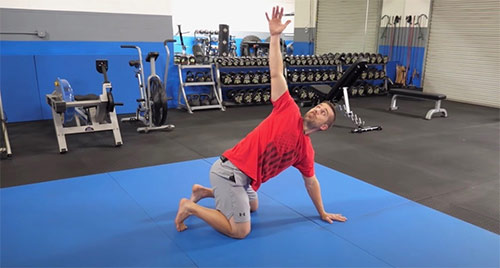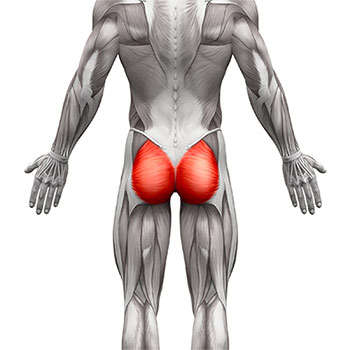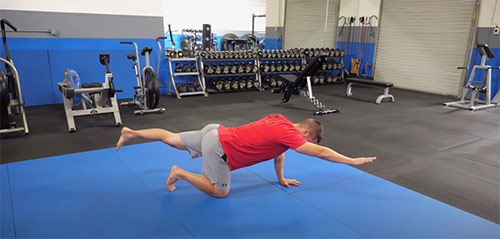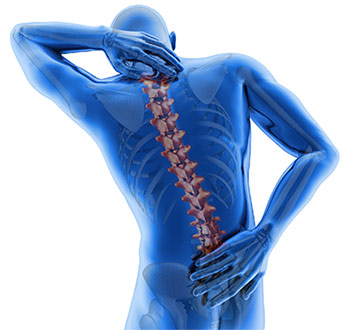
The back is a vulnerable place and it can develop over time – which makes a single bout of back pain or injury a real concern. It’s easy to get into a cycle of inactivity and pain that could easily persist for years or even decades.
Taking proper care of your back is absolutely essential for long-term health and independent mobility. We mean the basics, here: walking around, being able to live an active life, and chasing fitness goals.
Today we’re discussing some key mobility exercises and movements that could help you manage and/or fix back pain. Of course, you should seek medical help if your problem is severe or persistent, but we’re going to share some self-management pearls of wisdom! Read on if you want to keep your spine in one piece…
QL
This triangular muscle connects the spine to the hips and s often injured through poor muscular recruitment. It takes the brunt of lower back stress when your glutes and core aren’t working properly – which is very common due to sitting and inactivity.
This can lead to a tight or limited quadratus lumborum and – without proper movement and mobility – it can start to get very tight. This pulls on the spine and hips, and tends to feel like a very rapid-onset soreness, tightness, and even burning sensation to the side of the lower back.
The straddle stretch with opposite toe-touches is one of the best ways to start getting some movement into this muscle. You can also perform standing toe touches and spinal rotations to get movement in while keeping spinal rotation fluid and healthy.
Take time to get into position and move around a little within the stretching range. This helps you figure out where the most effective stretch is, but also just helps the muscle move in these different end-ranges.
Glutes
The glutes are primarily responsible for the stability of the lower back – and they tie it to the hip itself. Naturally, these are going to be ground-zero for some problems if you have restricted or tight glutes.
They attach at the spine and excessive tightness or poor movement range can easily show up as pain or discomfort in the spine and hips. Mobility here is a great way of reducing these burdens – and should be a steppingstone to better, full-range glute activation.
The pigeon stretch is one of the most common and effective stretches for the glutes, and you can modify it to get into other regions like the piriformis as well. You should also consider using the 50/50 stretch and kneeling glute stretch to really loosen it off.
These overlap well with other aspects of back health like control in the muscle groups and improving other regions’ flexibility/movement. This is great because you can get some real bang for your buck with relatively simple, easy exercises.

Hip Flexors
The hip flexors are the opposite of the glutes; they flex the hip, unsurprisingly. But they can become very tight and pull on the front of the hips, producing anterior pelvic tilt and even some excessive lower back arching.
This kind of position increases the risk of compression in the disks and – especially – pressure on the facet joint. This is a common form of back injury and reducing your risk through hip flexor stretching is a brilliant use of your stretching time.
There are a lot of moving parts in the lower back and it’s health, but proper hip flexor management and stretching is one of the first you should focus on. It’s a common area for stress during weighted movements, too, so it pays to stretch the hip flexors before and after exercise, too.
You should also be conscious of stretching the hip flexors without just opening up your core space. The stretch for a hip flexor shouldn’t change the position of your core or hips, because that’s compensation rather than stretching. Keep your core on and extend the hip itself.
Adductors
The adductors are the muscles of the inner thigh and they contribute to the stability of the hip, but restriction here will also show up in the position of the hips. As with the glutes or hip flexors, this demand on the hip can show up in the spine.
Remember that the spine is anchored to the hips and the health of the spine is inextricably linked to hip position and stability. Stretches for the adductors do include exercises like the straddle stretch, which we mentioned briefly earlier, as well as split-type exercises and the Kosack squat.
These can be really stubborn muscles to stretch, but once they’re able to move through full range it’s a comfortable practice to get into. You will move them through great range of motion with many kinds of exercise, so it’s easier to keep than to get!
T-Spine
Most people aren’t going to get pain in the upper back as often as pain in the lower back. However, it’s totally possible and the thoracic spine takes a lot of the brunt of desk living and inactive lifestyles.
There are two things to focus on: extension of the T spine, and rotation. These two are the key flexibility exercises you’ll need to put time into and they can really free up this segment of the back. You can cause some drastic, rapid-onset mobility changes if you’re diligent.
Extension of the spine come from effective foam rolling, with the core and glutes tight, extending the upper spine over the roller. It should also be paired with band pull-aparts and other scapular movements, to ensure maximal extension, since the two are closely connected.
You can also perform superman holds from the floor for this kind of thoracic extension. It helps you strengthen the spine in extension and should be paired with the T-spine extension we mentioned above.
Rotation is a little more difficult. You can combine the scorpion stretch and the iron cross to get some rotation into the mid- and upper-spine region. These are really helpful but will require regular practice – even if it’s only for a minute or two a few times a day.
We’ve written a whole article on the application of rotation and lateral movement for the spine, so if you’re interested you should check out that in-depth article!

Cat-cow, Dead Bug and Bird Dog: Mobility vs Stability
There’s a fine line between mobility exercises and their corresponding strength exercises. Any good mobility exercise will be incorporating some aspect of strengthening, control, and/or positional familiarity.
Nowhere is this more obvious for the back than in the use of the cat-cow, dead bug, and bird-dog. These exercises are crucial for improving your awareness of your core and they combine to strengthen and control key ranges.
You might say these aren’t mobility exercises, but they are simple bodyweight movements you can add into your routine to improve control, proper muscular coordination, and reducing the possibility of poor positions in the back and hips.
Cat-cows are a common warm-up exercise for the core and hips. This is a great way to feel where your spine is – and where it should be. The movement helps to mobilize the hips and lower back through controlled movement, as well as activating the muscles of the back and core, simultaneously.
The dead-bug and bird-dog are inverted versions of the same movement. The bird-dog practices spinal alignment during extension of the hip and shoulder, while the dead bug focuses on anti-rotation exercise in the core during the same movement.
They have similar goals but in opposite directions – and both move the hips and shoulders through range – focusing on position and mechanics while keeping the core and back in a neutral position.
The combination of improved movement with practice in the most important core position (neutral spine) is great for back health. It ensures you know where you should be, it strengthens that position, and it helps you to maintain it during increasingly complicated movement.

Getting pain-free in your back is something we can only offer vague guidance on. Each case is pretty specific and there are always concerns – we recommend seeing a qualified medical professional if you’re remotely concerned. It’s very easy for back problems to develop over time.
However, the application of mobility work and proper strengthening/control exercises like those we’ve mentioned can help manage your pain. It’s a step in the right direction whether you’re in pain now or not – it prepares you for long-term loading in a way that keeps you healthy.
We recommend taking your time and patiently incorporating some/all of these exercises. The best application is to get them in more often rather than for huge intensity/duration. Getting regular practice and mobility work in is the best way to affect change in the body.








June 4, 2020
Videos would be great!
June 11, 2020
Hi Martha and thank you for your feedback. Several of our blog posts contain videos from time to time and they are great to give an even better demonstration of many of the specifics discussed in our blogs. If you are ever want to check out some of the great video content that is available on our YT channels you will always find supplemental information there. Please check out Critical Bench, Exercises for Injuries and Critical Bench Compound on YT for excellent videos that can help.
September 5, 2020
I have such pain. The chiropractor says I have a rib that pops out. It hurts under my shoulder blade. I have had him put it in but it pops out again. Any helpful advice, I would appreciate.
September 8, 2020
Hi Chris,
I am so sorry to hear that this continues to happen. We are not doctors, therefore we cannot diagnose what may be the cause of this. However what I can suggest is that you seek medical attention to get to the root of why this continues to happen and in the meantime avoid any exercise movements that causes your shoulder to pop out. I hope this gets resolved quickly for you.